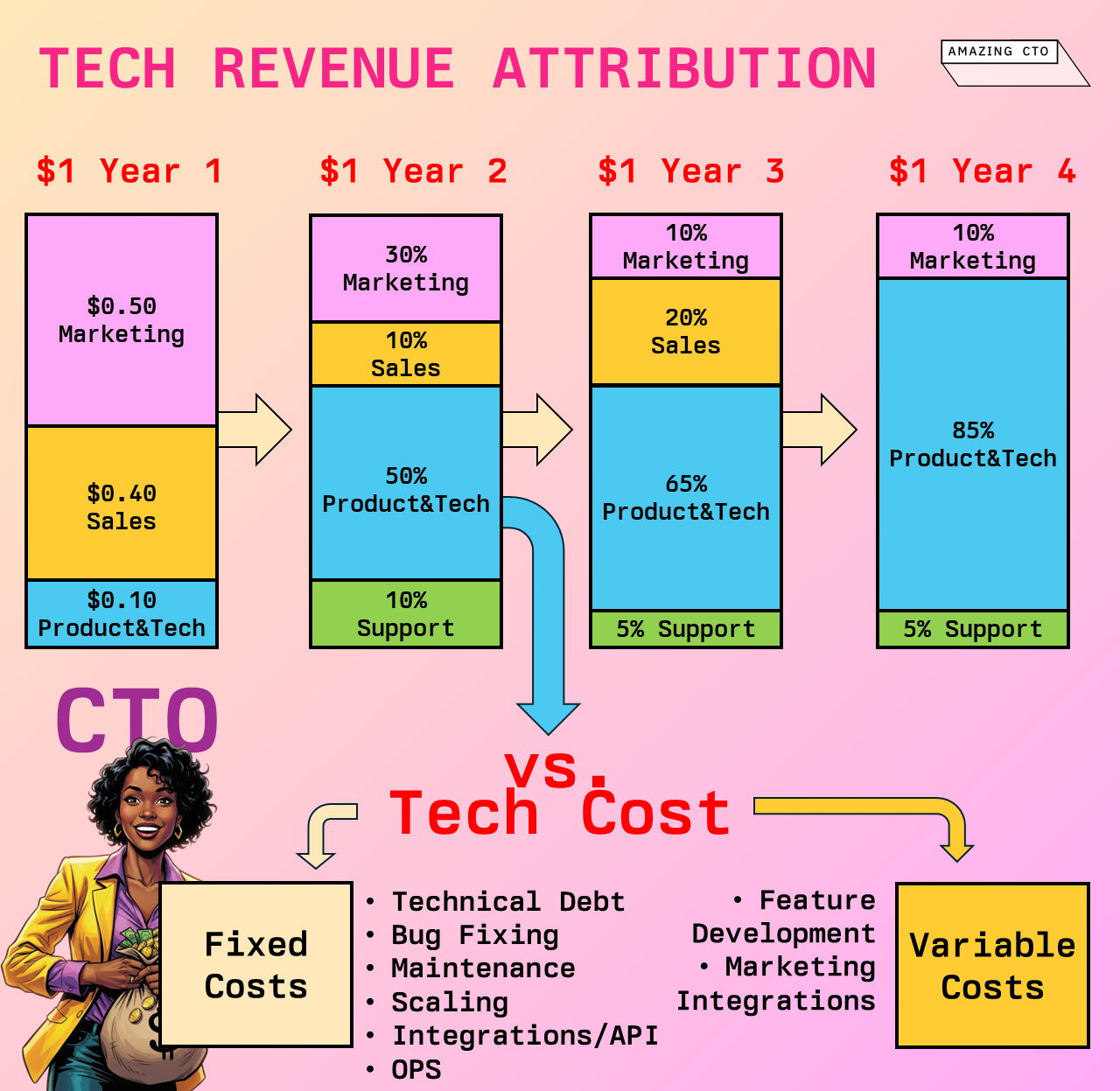Stephan Schmidt - October 13, 2025
Tech Needs a Revenue Attribution Model
A Clearer, Fairer Way to Attribute Revenue across Teams
TL;DR: Revenue attribution models, similar to marketing's cookie attribution, allow CTOs to quantify engineering ROI by splitting revenue across departments based on time-based contribution (e.g., product gets 10% of year-1 revenue, 50% of year-2), then dividing attributed revenue by engineering costs to transform from cost center to profit center. Track fixed costs (keeping lights on) and variable costs (new features) separately to measure ROI of innovation versus maintenance.
Tech needs a revenue attribution model.
One question many CTOs get asked: What is your return on investment? And there are two parts to answer this question. The first one: What is the return? Second, what is the investment?
Revenue Share
Let’s start with the second question first. What is the return? When looking at companies I often see companies attributing the same revenue $1 several times. Sales says they brought in that dollar, marketing says they bring in that dollar, product says they bring in that dollar. Product makes claims in business cases on how much each feature is worth - but because everyone claims the same dollar and overestimates their impact, the numbers can’t be trusted. While the company claims $3 of revenue ($1 by sales, $1 by marketing, $1 by product), the CEO only sees $1.
Revenue attribution is not something new. Marketing does this all the time with affiliate marketing. They have strategies to distribute commission for leads to different parties, e.g. with first-cookie or last-cookie attribution models. Attribution models split the $1 but don’t overcount.
One useful revenue attribution model is a time based one, especially for SaaS companies - but it works for every recurring business like bookings and to some degree for all businesses. You attribute $1 revenue from customers differently over time.
In the first year of the customer, you attribute
- $0.50 to Marketing
- $0.40 to Sales
- $0.10 to Product

Marketing brought in the lead, Sales made the sale and product produced something to be sold. Attribution is splitting the $1 for the contribution everyone made to create the $1 of revenue. This model is one part based on numbers, surveys, customer questionnaires and one part on negotiation between the departments.
In the second year, marketing contribution is less, but ads that the customer sees make them stick with the product, as might do a newsletter. Sales does some outreach and upselling to customers. Customer support keeps customers happy and on board. Product becomes most important because customers mainly stay with the company because of the product.
A split might be:
- 30% to Marketing
- 10% to Sales
- 50% to Product
- 10% to Customer Support
Over the next years the attribution shifts again.
You can also do attribution of revenue by customer, if you fine grain track the customer journey, e.g. customers who contacted customer support and renewed/didn’t churn, get more customer support attribution. Customers who were won back by sales, have a higher sales attribution. Customers who upgraded their package have a product attribution and so on. This is way more detailed and reflects reality better, with the downside of being much more difficult to understand and implement.
Now we can calculate the revenue driven by each department. We take all customers and depending on the year they are in, we distribute the $1 to the departments.
Cost
Cost is everything you need to create and operate the model. This is enough to calculate return of investment, the revenue driven by product vs the cost for product/technology.
It is often interesting to split costs into two buckets, fixed costs and variable costs. They are not exactly the same terms like economists would use, but suitable enough.
Into fixed costs you put everything to keep the lights on. While there are some variable costs stuck in there, you can serve 1000 and 1,000,000 customers today with the same minimal setup of servers and DevOps people. So I consider them fixed for many company sizes (not true for Netflix :-) This includes:
- DevOps
- Fixing tech debt
- Bug fixing
- General maintenance
- Scaling
- Core Integrations
- APIs
The variable costs are everything else, everything you would not need to keep the lights on, usually:
- Features Development
- Marketing integrations
- Partners integrations
- B2B customizations
ROI
ROI calculation is now easy. You take the revenue driven by product and technology and divide it by the cost for product and technology - and you can give the CEO a number.
If you want to understand your cost structure better, split the attributed revenue by feature usage. The way customers use new and old features, you attribute the revenue either to Bucket 1 or Bucket 2. Then you divide Bucket 1 / variable costs is the ROI for new features, Bucket 2 / fixed costs is your ROI for old features - what you would make if you just keep the lights on but do not invest into product growth.
Instead of being a cost center, you become a profit center.
About me: Hey, I'm Stephan, I help CTOs with Coaching, with 40+ years of software development and 25+ years of engineering management experience. I've coached and mentored 80+ CTOs and founders. I've founded 3 startups. 1 nice exit. I help CTOs and engineering leaders grow, scale their teams, gain clarity, lead with confidence and navigate the challenges of fast-growing companies.
